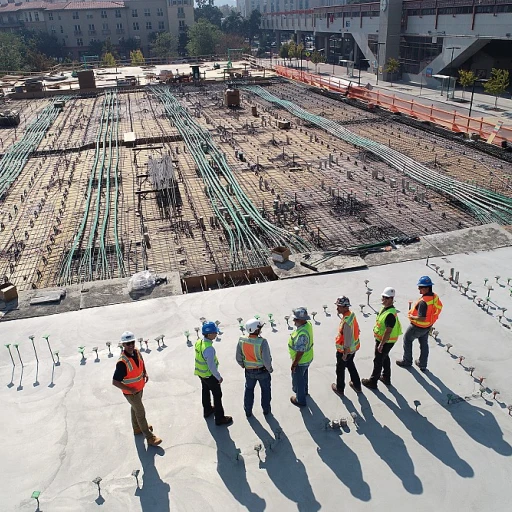
Understanding the Modern Intranet
Revolutionizing Communication: The Heart of the Intranet
The modern intranet has transformed into a pivotal tool for companies aiming to enhance internal communication. By leveraging cutting-edge technology, intranets now offer more than just a repository for documents—they foster a dynamic, interactive platform that uplifts employee experience. Companies are utilizing these digital hubs to bridge communication gaps, ultimately driving both individual and organizational growth.
The shift from static environments to more engaging and user-friendly interfaces is noteworthy. Modern intranets are designed with employee engagement at the forefront, incorporating features that support real-time communication and collaboration. These platforms facilitate not only day-to-day business operations but also create a space for social interaction, thereby improving employee morale and connectivity.
Moreover, the addition of mobile access has further extended the reach of modern intranet systems. Employees can stay connected to their workplace from virtually anywhere, enhancing their ability to contribute effectively even when they’re on the go. This level of accessibility and flexibility is essential in today's fast-paced digital workplace.
To ensure a positive user experience, companies focus on intuitive intranet software that assimilates seamlessly into the fabric of daily work life. Features like content management systems, social intranet tools, and cloud-based solutions provide an integrated environment for fostering collaboration and knowledge sharing among team members.
In essence, the transformation of intranets into comprehensive digital ecosystems has marked a new era in enhancing communication within the workplace. This evolution not only supports internal communication but also lays the groundwork for streamlined HR processes and increased employee engagement, as will be explored further in the following sections.
Key Features of a Modern Intranet
Essential Elements of a Cutting-Edge Intranet
In the evolving landscape of the digital workplace, understanding the components that make up a modern intranet is crucial. A company's intranet is no longer just a repository for documents; it is an integral tool that facilitates real-time communication, employee engagement, and efficient content management. Here, we'll delve into the key features that define a truly modern intranet.
A standout feature of today’s company intranet is its user-friendly design, which ensures seamless user experience for employees across all departments. Embracing a cloud-based infrastructure is vital as it allows employees to access essential resources anytime, anywhere—be it from their desktop or mobile devices.
The social intranet takes center stage by promoting social interaction through features such as internal communication tools, discussion forums, and collaboration spaces. This functionality not only enhances employee engagement but also fosters knowledge sharing which is critical for a company’s growth.
Modern intranets are equipped with integrated intranet software solutions that facilitate content management and improve the overall employee experience. These solutions often include tools for managing digital content, user permissions, and version control, leading to more efficient internal workflows.
Another notable component is the ability to personalize content delivery for each user. This tailored approach ensures employees only see what is relevant to them, thereby boosting their productivity and overall workplace satisfaction.
Finally, the incorporation of analytics features offers valuable insights into how employees interact with the intranet, enabling companies to continuously refine and enhance the platform to better meet employee needs.
With these foundational elements, modern intranets play an integral role in shaping a cohesive and dynamic work environment, making them indispensable tools for today’s companies striving for innovation.
Impact on Employee Engagement
Elevating Employee Engagement through Modern Intranets
A modern intranet plays a pivotal role in boosting employee engagement in today's digital workplace. By providing a user-friendly platform for internal communications and collaborative tools, it transforms how employees interact with their company and each other. The user experience offered by modern intranets is tailored to suit the needs of a diverse workforce. Social intranet features foster a sense of community and belonging, which ultimately enhances employee engagement. Employees can access company content and interact with colleagues in real time, creating an engaging digital employee experience. Mobile access is an essential component of a modern intranet, especially for companies with remote or on-the-go employees. By ensuring employees have seamless access to tools and resources from any location, companies can maintain connectivity and encourage participation, thereby enhancing the overall employee experience. The integration of personalized content and knowledge sharing features also contributes to increased engagement. By allowing employees to engage with relevant content, intranets empower them to be more informed and motivated. Additionally, intranet software enables internal communication teams to curate content that resonates with employees, encouraging interaction and building trust within the organization. This effective content management directly impacts employee morale and reinforces a positive workplace culture. To harness the full potential of a company's intranet, it's crucial to leverage the latest advancements in intranet software. By doing so, organizations can ensure that their digital workplace is both engaging and efficient. For more insights on optimizing employee engagement and essential skills for HR Directors in the age of innovation, explore relevant resources like this comprehensive guide.Streamlining HR Processes
Optimizing Efficiency with Intranet Solutions
The integration of a modern intranet plays a pivotal role in streamlining HR processes, providing both efficiency and a better employee experience. By harnessing the capabilities of intranet software, companies can facilitate seamless internal communications and improve access to essential resources, making the digital workplace more effective.
A well-deployed intranet can centralize HR tasks, enabling a unified space where employees can access necessary tools and features, such as payroll information, benefits, and training materials. This centralized content management not only supports knowledge sharing but also enhances user experience by providing real-time updates and relevant content.
Moreover, with the aid of social intranet features, HR departments can foster collaboration and engagement among employees. These tools allow for a more interactive experience, encouraging employees to voice their ideas and feedback, paving the way for an inclusive workplace culture.
Embracing a mobile-first approach ensures that employees can access the intranet even on-the-go. This flexibility is crucial for maintaining a connected workforce, especially in remote or hybrid working environments. By making intranet access user-friendly and mobile-optimized, companies can ensure a more cohesive digital employee experience.
Implementing a cloud-based intranet further optimizes HR operations by providing scalable solutions that can adapt to an organization's evolving needs. This adaptability enhances both the efficiency and effectiveness of internal communications and employee engagement efforts.
Challenges in Implementing a Modern Intranet
Overcoming Barriers to Seamless Implementation
Implementing a modern intranet within a company comes with its own set of challenges. Despite its numerous benefits, from enhanced employee engagement to streamlined HR processes, transitioning into a digital workplace environment involves overcoming a few hurdles. Firstly, the existing company culture can sometimes resist change, especially when it involves embracing new digital tools. Employees might feel overwhelmed by the shift to a new platform. Therefore, it's essential to foster an environment conducive to open communication, encouraging employees to voice concerns and questions. Providing comprehensive training can ease this transition, empowering employees to maximize the intranet's features for collaboration and internal communication. Another significant challenge lies in integration with existing systems. A company intranet must seamlessly integrate with existing digital tools, providing a cohesive user experience. This requires advanced planning and collaboration between IT, HR, and other departments. Intranets today are expected to offer mobile access and be cloud-based, ensuring that employees have access to tools in real time from any device. Data privacy and security are also critical concerns. The introduction of a digital employee engagement platform could raise questions about how personal information is protected. Adopting robust intranet software with strong security measures is essential to maintaining trust within the workplace. Regular updates and audits ensure that content and user data remain secure. Finally, managing content efficiently is key. A modern intranet needs to be user-friendly, with intuitive content management features. Regularly updating information and facilitating knowledge sharing ensures that the intranet remains a valuable resource for employees. While challenges exist, they can be mitigated with strategic planning, effective communication, and by leveraging the right intranet solutions. Companies that focus on enhancing the digital employee experience will find themselves better equipped to handle the innovative intranet landscape.Future Trends in Intranet Development
Embracing Future Developments in Intranet Solutions
The digital transformation of the workplace continues to evolve, and modern intranets are at the forefront of this change. As companies strive for more efficient communication and boosted employee engagement, the future of intranet development promises exciting possibilities. Let's explore what lies ahead.
Future developments in intranet solutions will likely prioritize seamless mobile access, ensuring employees can connect and collaborate from anywhere in an increasingly mobile-dependent world. The need for real-time communication tools within intranets will also grow, enabling instant feedback and more dynamic internal communication.
Another trend is the rise of social intranets, which integrate features reminiscent of social media platforms to foster a more interactive digital workplace. Engagement tools such as forums, polls, and social feeds will transform how employees share knowledge and interact within the company.
Personalization will play a crucial role in intranet software moving forward. By using advanced algorithms and data analytics, companies can tailor the intranet experience to individual user needs, improving the overall user experience and enhancing employee satisfaction.
The integration of cloud-based solutions will further simplify access to resources and ensure quicker updates and scalability. Such solutions will make intranets more user-friendly and adaptive to the changing needs of a digital employee base.
As companies adopt advanced features, they will also need to address challenges related to data security, privacy, and content management. Ensuring that the intranet remains a safe, efficient tool while offering innovative functionalities will be paramount.
To remain competitive, companies must keep an eye on these trends, investing in the right tools and striving to create an intranet modern in both design and function. It's an exciting time for intranet technology, as the focus shifts toward creating a holistic digital employee experience that benefits both employees and the company as a whole.












